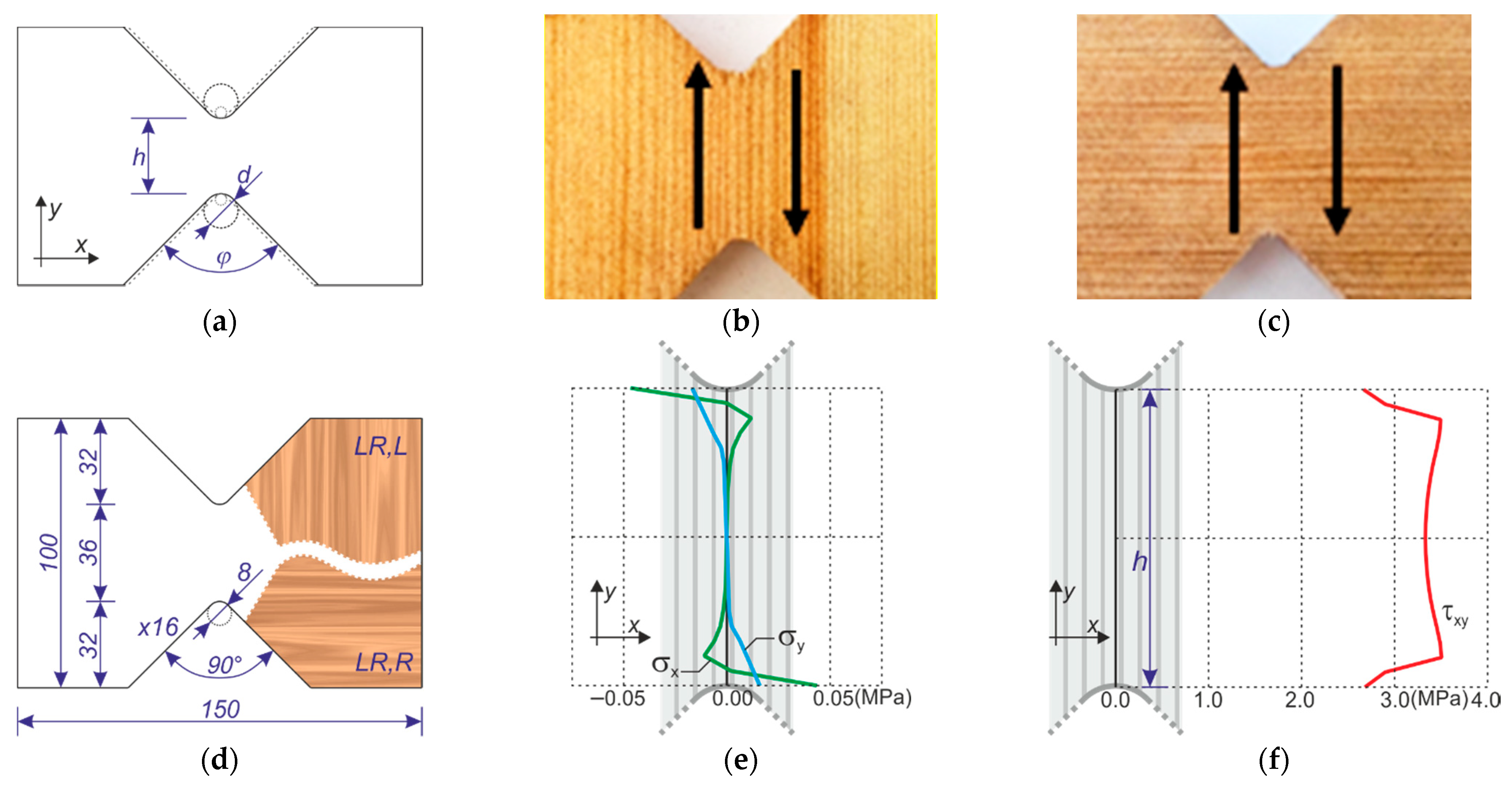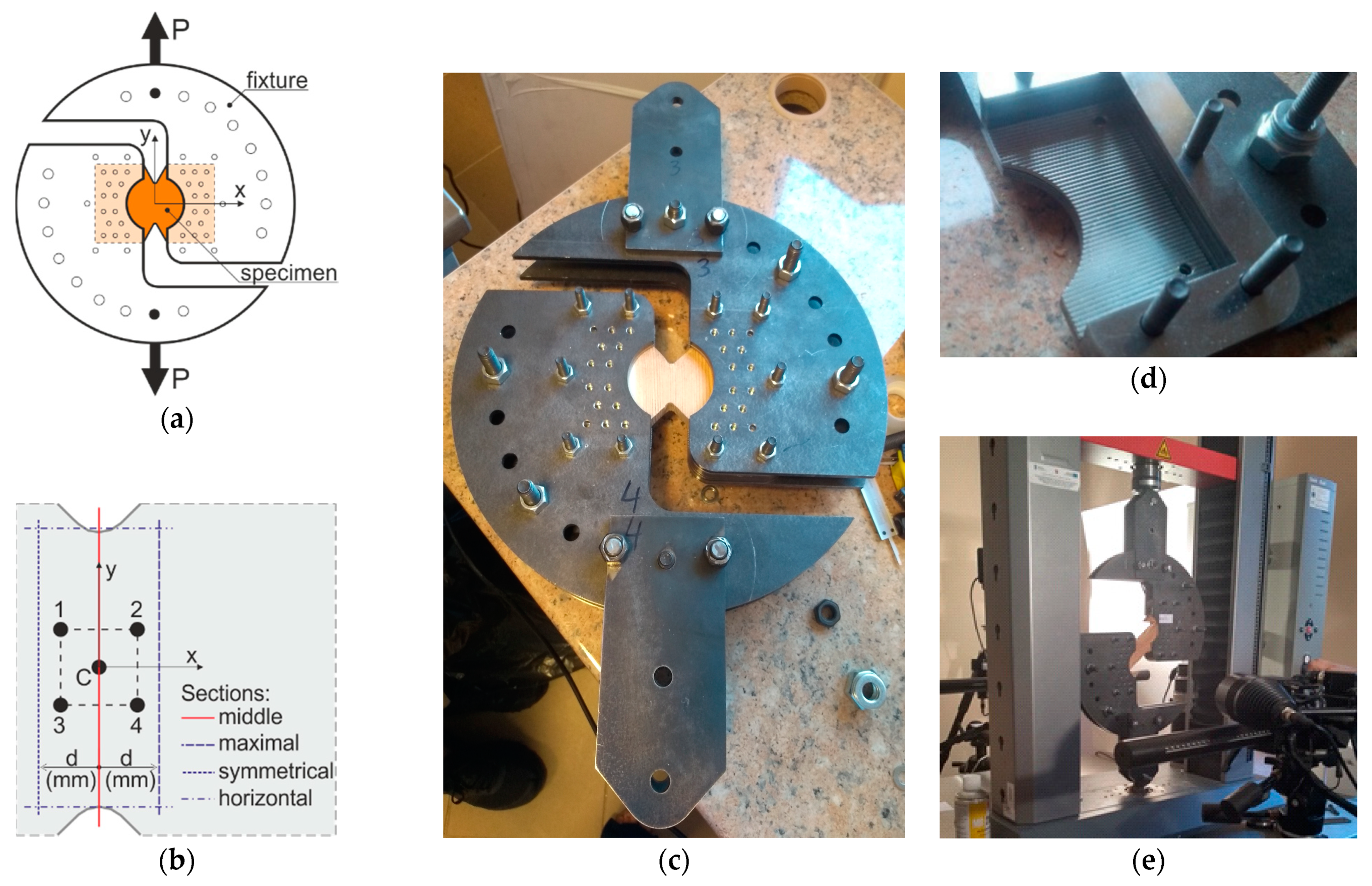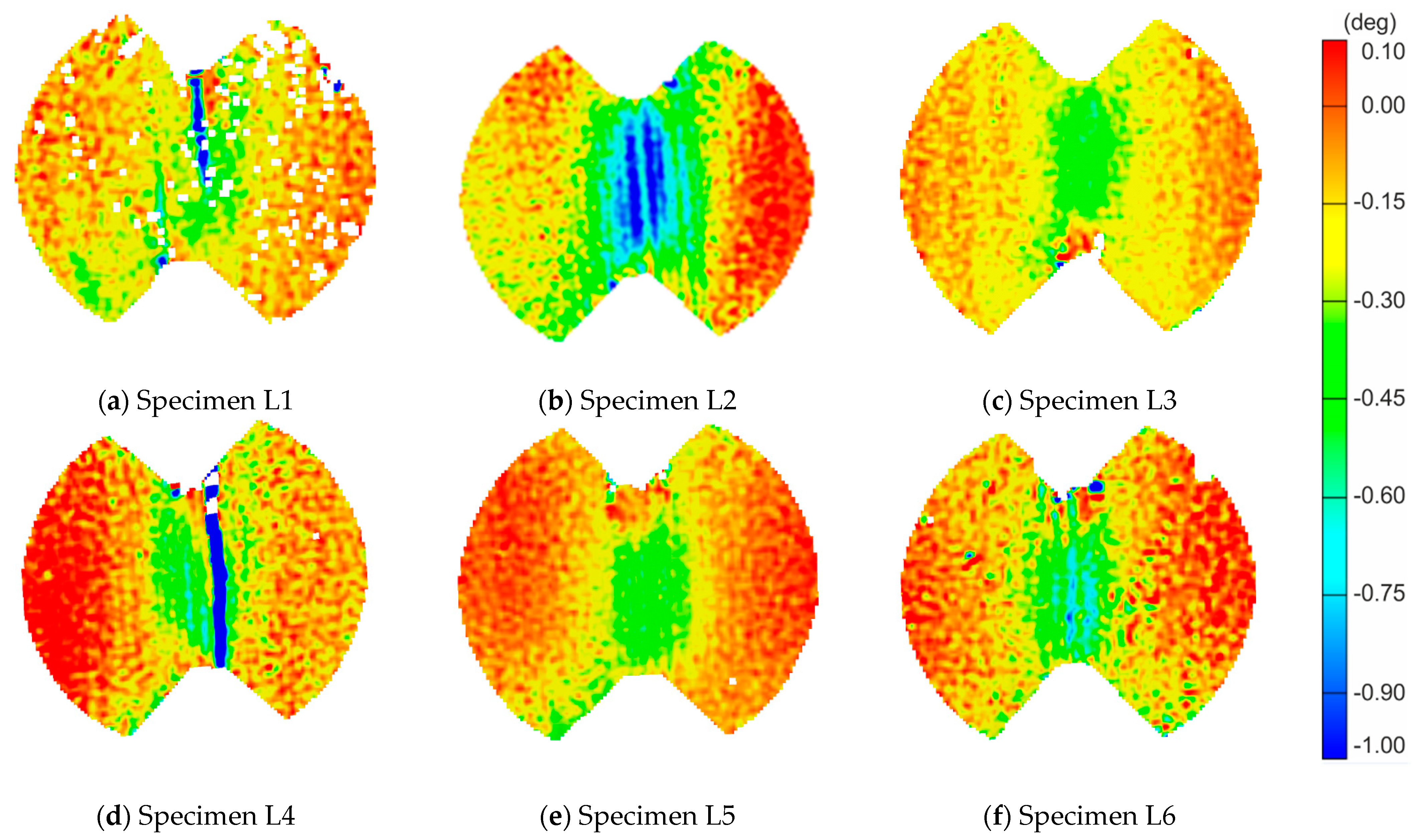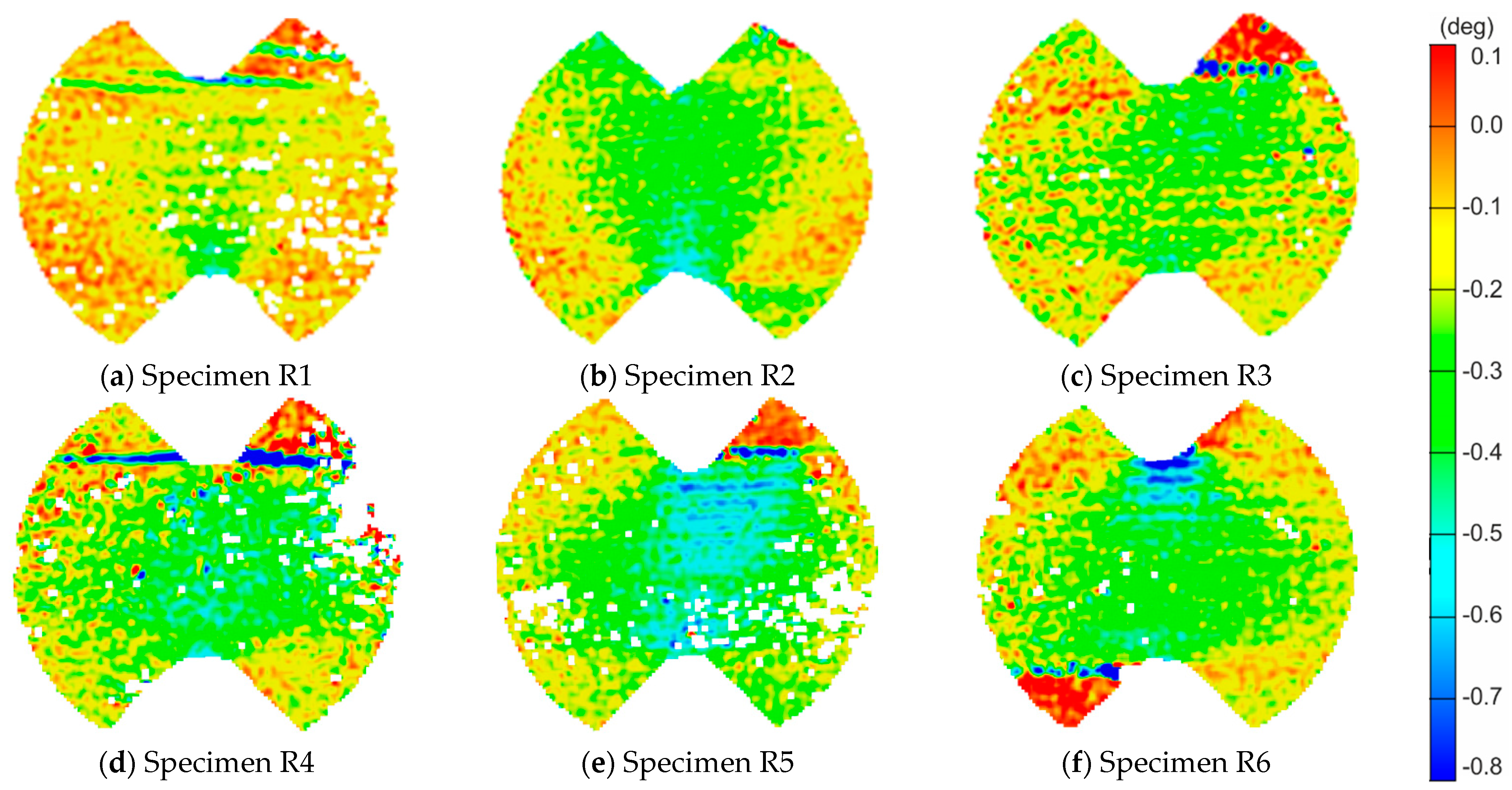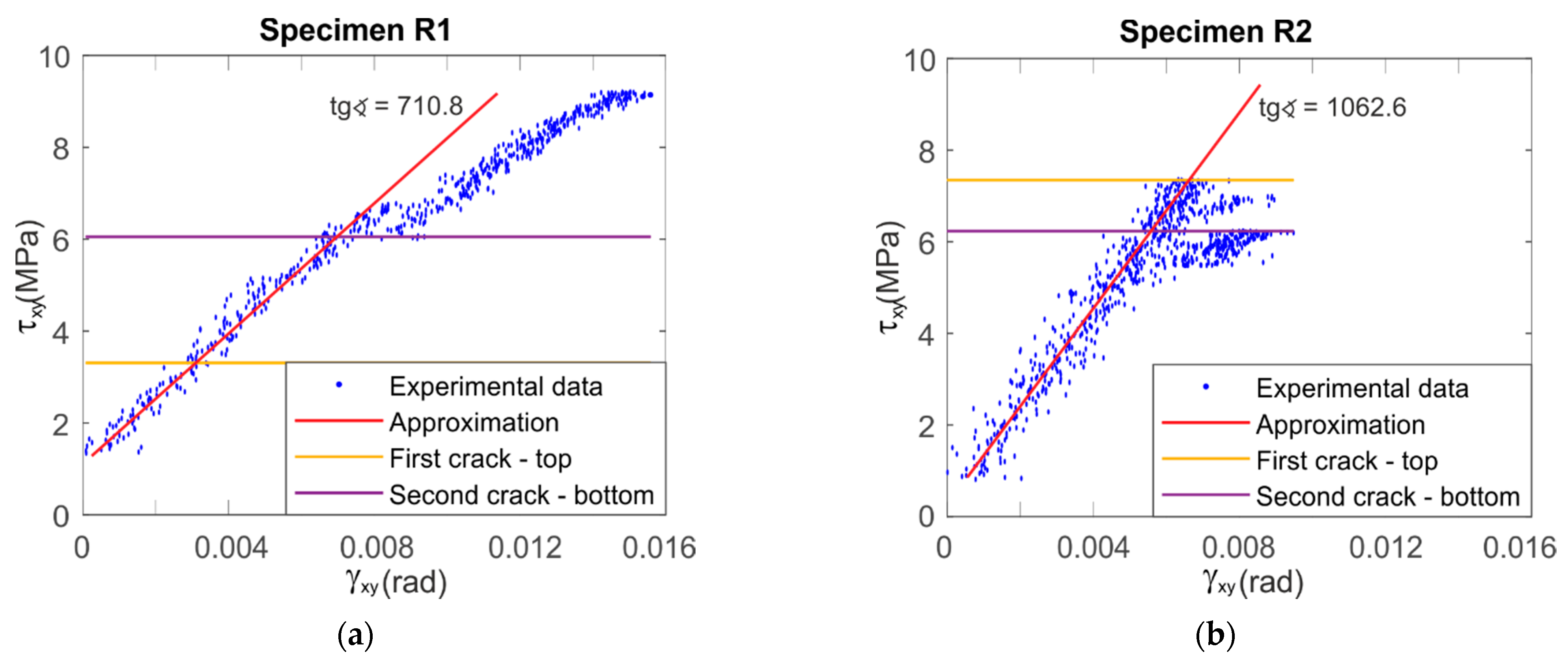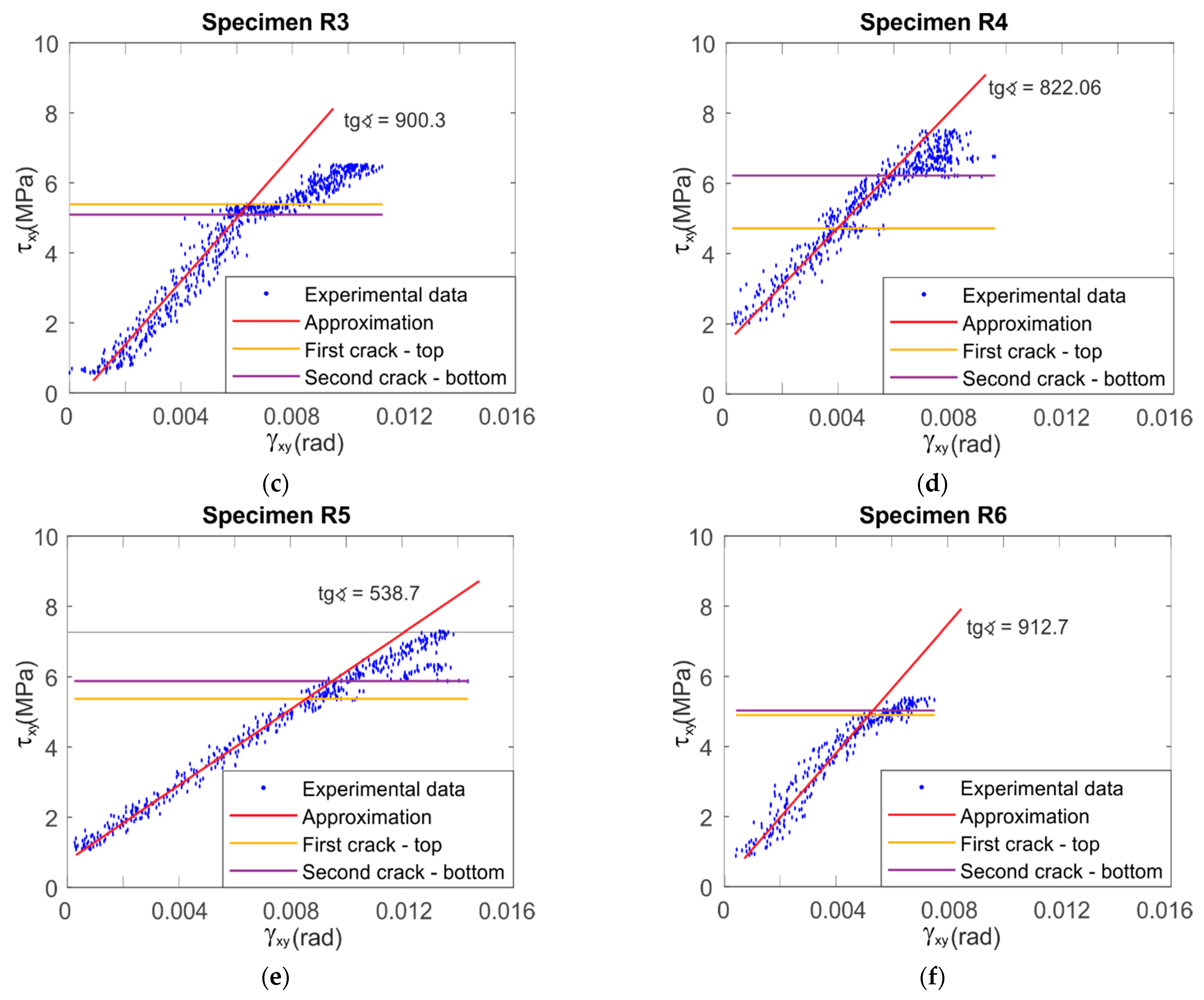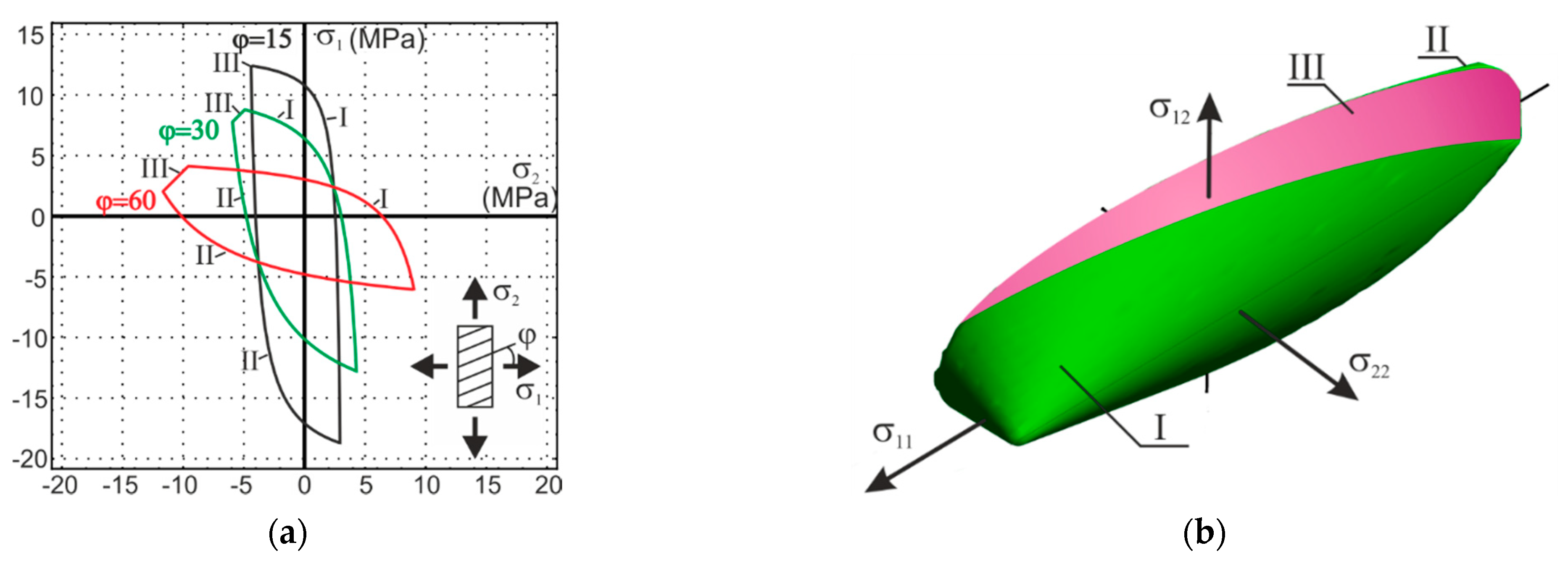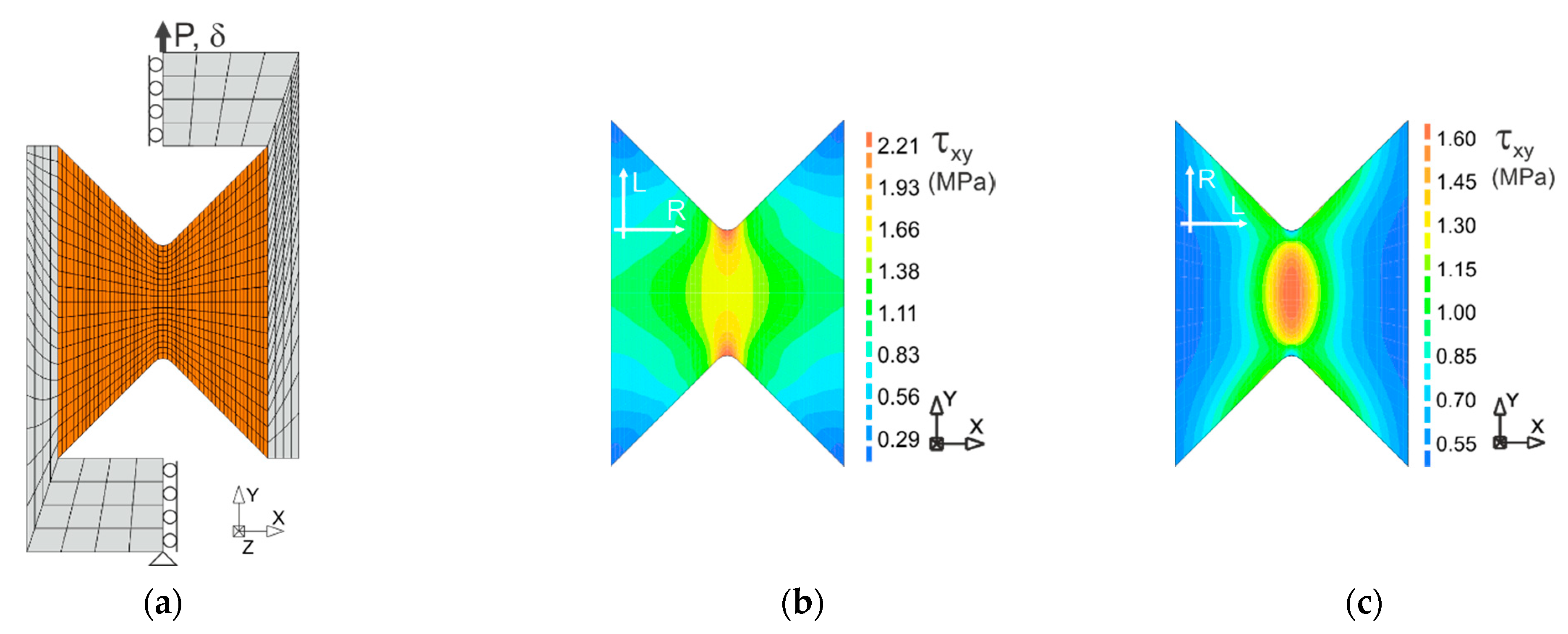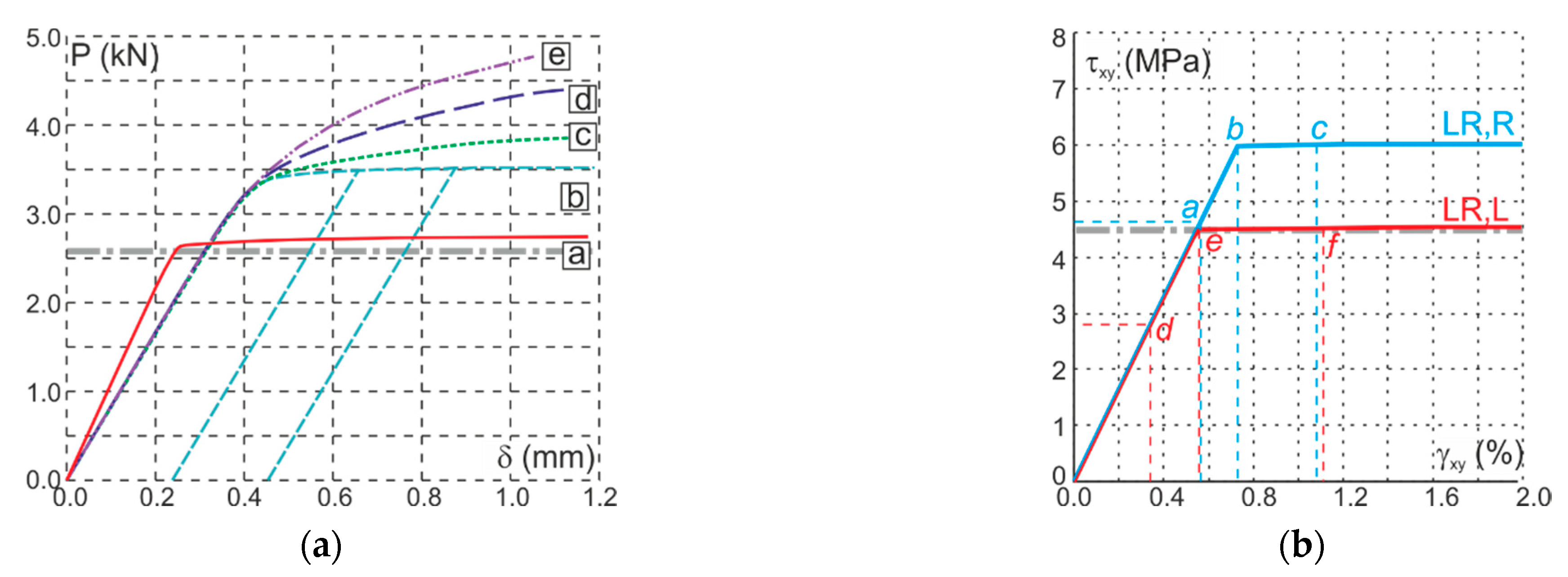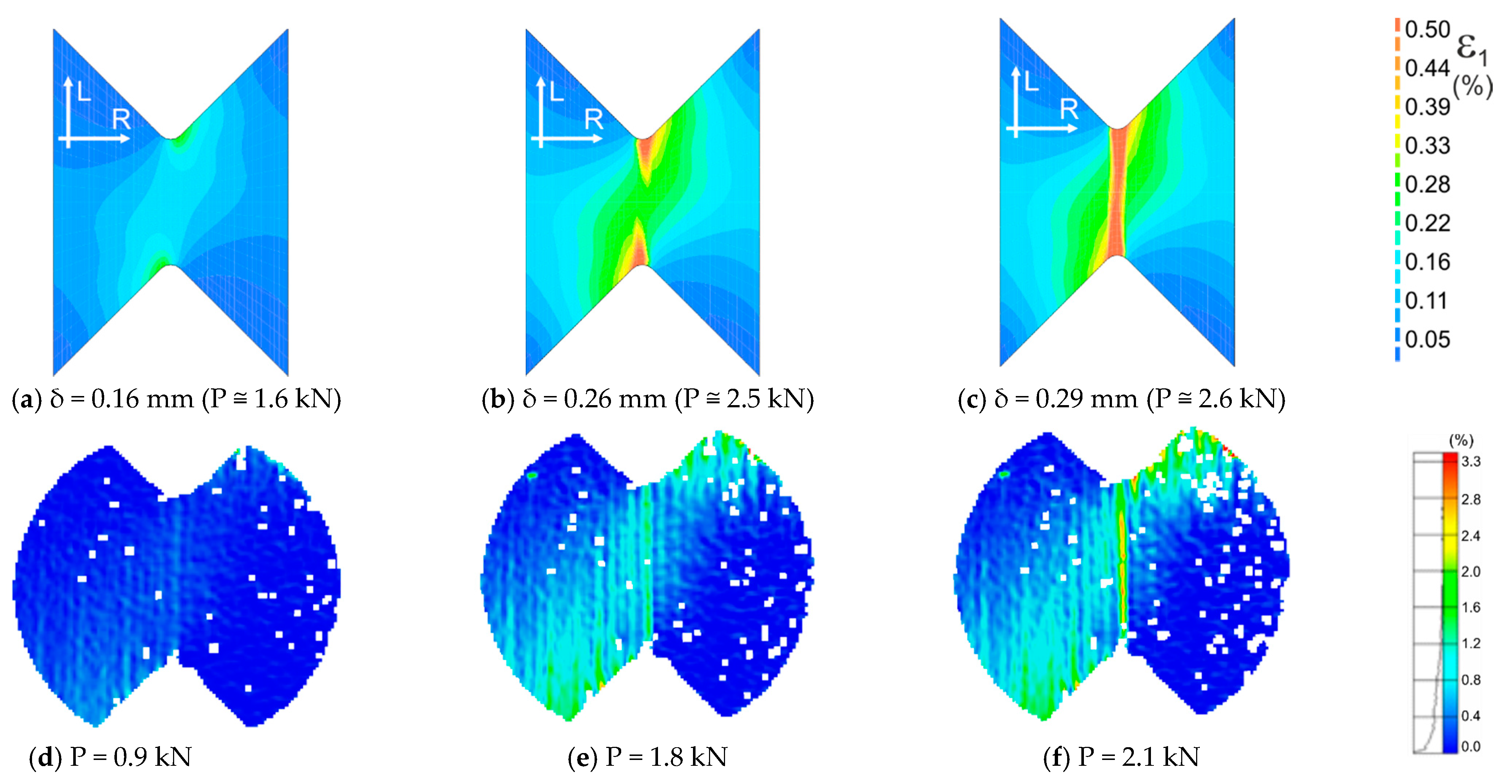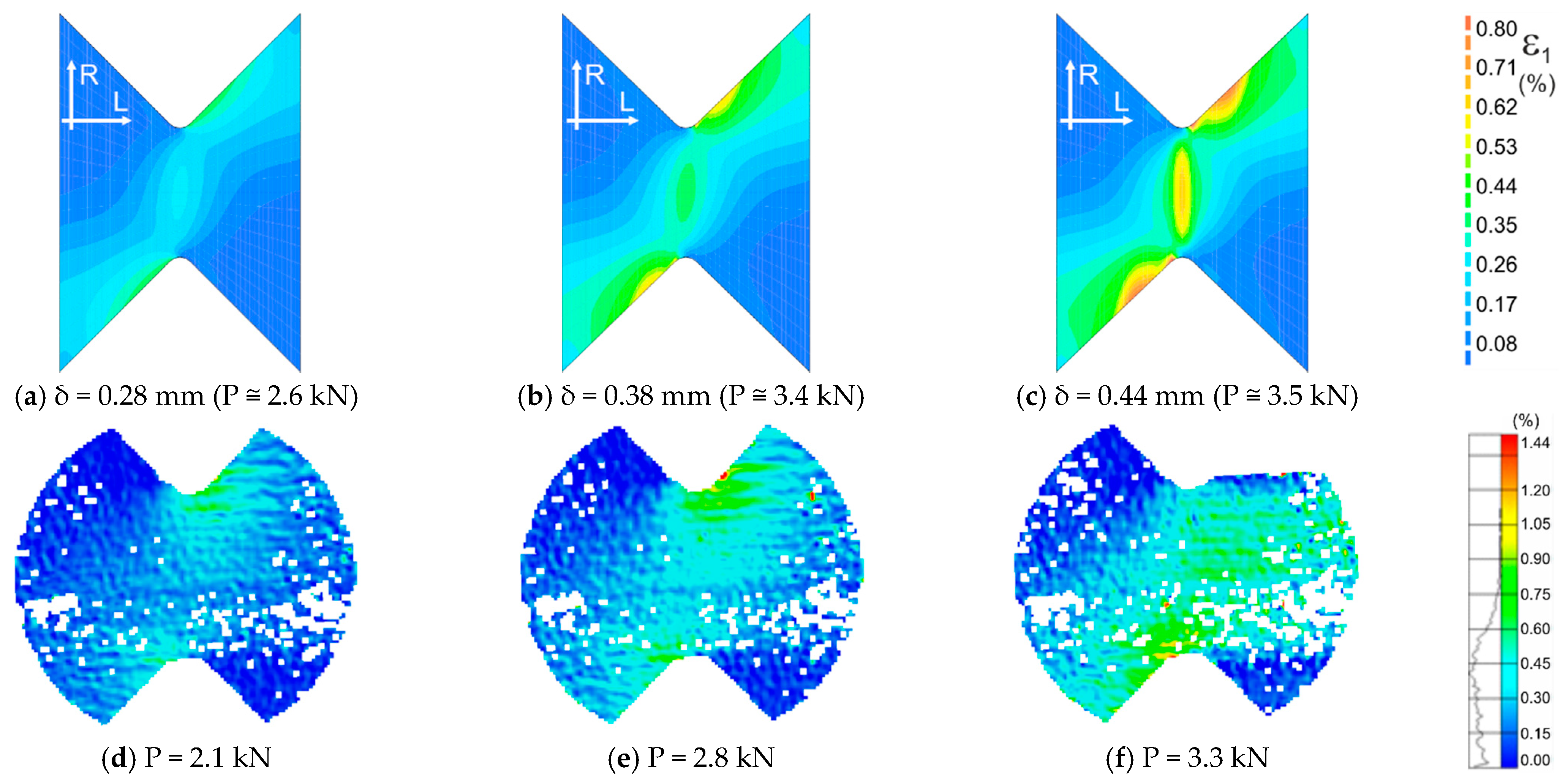2.1. Background Theory
The 2D strains components, the normal strains
and the shear strain
, are directly calculated in the software of the digital image correlation system [
13] from the symmetrical material stretch tensor
:
where
is the deformation gradient. The shear angle
without the rigid rotation is calculated as:
where
and
are the corresponding shear angles of the two sides of the deformed elemental square (see also [
7]). Note that the software gives the strains and angles at the certain points referring to an arbitrary coordinate system
.
The constitutive law of linear elasticity for the orthotropic material is determined by nine independent material parameters because of the strain and stress tensors symmetries and the existence of the elasticity energy function. As is the case for the orthotropic material, the formulas of Hooke’s law depend on the orientation of the coordinate system in a reference to the principal axes of material symmetry, i.e., the axes of orthotropy. The shear moduli in the frame of reference aligned with the orthotropic axes, so-called the technical moduli, can be calculated independently of other material constants as:
where
are the shear components of the stress tensor in the planes
respectively, and
are the corresponding shear angles.
To determine the shear angle
in the chosen plane, the following engineering geometrical considerations is used additionally. Let us consider an infinitely small element in the plane
, which is in a state of pure shear (
Figure 2b). When shearing, the right angles change by the value
. The one diagonal is then lengthened with the strain
and the second diagonal shortens with the strain
and:
where
is the diagonal length of the element. From (4), we get:
To derive the engineering shear angle in the DIC system, the construction of the virtual strain gauges is required in the same way as for two-element strain gauge rosettes, e.g., for a 10 × 10 mm2 square, where are the linear strains, perpendicular to each other and directed at 45° angle to the shearing load.
2.2. Specimens, Equipment and Methods
The dimensions of the specimen were preliminarily defined by the basic numerical tests on several different configurations of the critical cross-section height and curvature. Nine different shapes were modeled checking stress distribution by means of the finite element method. The dimensions modified were: the shear area height
mm, the initial diameter
mm and the inclination angle
of the cutting lines (see
Figure 3a). The aim was to achieve a pure shear state in the middle section of the specimen; hence, it was sufficient to adopt an isotropic material and perform the simplified analysis only in the elastic range. The most satisfactory results were obtained for the following dimensions:
mm,
mm and
(all dimensions are shown in
Figure 3d). The obtained tangential stress distribution was characterized by low variability with practically zero values of the associated normal stresses. The stress distributions for the middle cross-section are shown in
Figure 3e,f.
Storage and processing of wood specimens were performed in normal conditions of 65% relative humidity and temperature of 20 °C. The pre-specimens were firstly cut from 16 mm planks (planks cut from the central part of the log) of pine wood (
Pinus sylvestris L.) with rectangular dimensions of 100 mm × 150 mm concerning two perpendicular directions of LR plane (in
Figure 3b,c, the arrows show the shearing directions with respect to the material axes). Further, the notches were made using a milling-machine with a down spindle and a saw to create the required shape (
Figure 3d). The tests were performed immediately after the transportation to the testing facility and prepared for the DIC measurements. Therefore, the surface of the specimens was sprayed using a black aerosol can to create a more stochastic pattern. Since wood has an inhomogeneous surface, there little paint was needed. Further, the specimens were inserted into the Arcan fixtures (
Figure 4). The fixture dimensions and shape were designed by the authors and water cut from an 8mm thick stainless-steel plate. The fixture elements were connected by 8 and 12 mm steel screws with steel plates used as distances, while the specimens were tightened by steel tooth plates (
Figure 4d).
The test was performed using the 10 kN nominal force universal testing machine, equipped with the Arcan fixture. A digital image correlation system [
13] was used to obtain the full-field displacement distribution and visualize the shear strain uniformity. The testing machine gave information on the forces, while the DIC system on the shear angles. The preparation of the DIC system started with choosing the calibration object, here the manufacturer’s CP90/20 was used, which allowed measuring an area between 78 × 65 mm
2 and 130 × 105 mm
2 (final area was approximately 85 × 70 mm
2). Afterwards, the typical system calibration was performed. The software options were chosen as: facet size 19 × 19 pixels and faced step (distances between facets) 15 × 15 pixels, as proposed by the manufacturer. The DIC used in this experiment was composed of two 5Mpix cameras (resolution 2448 × 2050). The starting points for calculations were chosen, as recommended, at areas where the displacements were minimal (typically, the lower left part of the specimen). The experimental setup of the DIC system is shown in
Figure 4e.
Twelve specimens were tested. Six of them were oriented so that the shear direction was parallel to the L axis (LR,L-specimens) and the other six with the shear direction parallel to the R axis (LR,R-specimens). Both tests were tracked automatically by displacement with a constant value of 0.35 mm/min and an initial force of 130 and 70 N for the LR,L and LR,R specimens, respectively. The ultimate forces were taken from the testing machine at the moment of failure (LR,L specimens) and at the moment of first horizontal crack (LR,R specimens). The values of ultimate shear angle and shear modulus were calculated for central point of the cross-section (indexed “c”) (Point C in
Figure 4b and Expression (2)) and for Points 1–4 presented in
Figure 4b (indexed as “g”) (from the virtual gauges located on the diagonals of the central square of 10 × 10 mm
2 and Expression (5)). The ultimate shear angle values were taken at the moment of failure.
The calculations of the LR shear moduli were performed according to Formula (3) with the shear angle obtained from (2) for the
moduli and with the shear angle obtained from (5) for the apparent
moduli. The shear modulus was determined as a secant modulus in the range between 25% and 50% of the maximal external force
in each specimen. Such values were chosen due to very small shear angles for the measuring system resolution (initially 10–40% of the maximal force was considered). The expression for calculating the modulus from the experimental results can be written as follows:
where the shear angles are taken as from Equation (2) or (5) for
and
, respectively. The nominal shear stresses
were computed as a ratio between the force
and nominal cross-section
, i.e.,
.
The shear angle maps were generated by the software for stages just before the failure i.e., rupture for the LR,L specimens and first horizontal crack for the LR,R specimens. Three different vertical sections were prepared to provide complete information on the distribution of strains along the cross-section of the LR,L specimens, as shown in
Figure 4b: the “middle cross-section” (red continuous line), the “maximal cross section” (blue dashed line) and the “symmetrical cross section” (blue dashed line). For the Specimens LR,R, two sections of different lengths were used: the “middle cross-section” and the horizontal blue dash-dot one.
In addition, for the obtained relationship, a linear approximation of results was done by the use of the least square method. The method finds the best fit, in this case the shear moduli itself, which is a tangent of the angle between the linear fit and the horizontal axes. The shear angles were taken from Expression (2) and the fitting range was 25–100% of the maximal external force (rupture in LR,L direction and first crack in the LR,R direction).
2.3. Results
The post-processing of strain values was performed in the DIC software. Maps of the shear angle and charts at the moment just before failure for all six LR,L specimens are shown in
Figure 5 and
Figure 6, respectively.
The LR,L results in the maps of shear angle show different failure sections. The maps for Specimens L1 (
Figure 5a) and L4 (
Figure 5d) clearly show that the failure arises not in the central cross-section as expected, but next to it. This is generated due to the material inhomogeneity, where most likely a wider strip of earlywood was defining the path of failure. The strains in Specimens L2–L6 are concentrated around the central part of the specimen. In addition, Specimens L3, L5 and L6 present more uniform strain distribution among the others.
Figure 6 shows the distribution of the shear angle along vertical sections. In general, the distribution of deformations in the central part is close to parabolic. However, in the case of Specimen L3, there is a more even distribution across the width as compared to sections from the symmetrical to max section (
Figure 6a). In Specimen L2 (
Figure 6b), the greater values of the angle, and hence the greater stress intensity, are on the right side of the central axis.
In
Figure 7 and
Figure 8, we can find similar information for LR,R specimens.
Figure 7 shows the deformation maps. The failure crack occurs horizontally along a line taken from the edge of the weakened central section (see Specimens R1, R3, R4 and R6 in
Figure 7). In
Figure 8, an increase in the value of shear strains can be noticed in the vicinity of the initial and end coordinates corresponding to the edges of the specimen (vertical middle section, black solid line). The red line of the results for the horizontal section also shows the highest values in the middle, i.e., near the critical edge.
The obtained results on shear moduli, ultimate strength and strain are shown in
Table 1 for the LR,L specimens and in
Table 2 for the LR,R specimens. The apparent shear modulus
and apparent ultimate shear angle
from Expression (5) the coefficient of variation (COV) did not exceed 24%, which are quite big but at an acceptable level in wood. The same values calculated by (2) show acceptable COVs for the modulus (
) and a moderately high value for the ultimate shear angle (
).
The values of shear strength for the LR,L specimens had a mean value of 4.4 ± 0.7 MPa, with a standard deviation of 0.85 MPa and a COV of 19.2%. The ultimate force had a mean value of 2448 ± 404 N, a standard deviation of 492 N and a COV of 20.1%. The apparent shear modulus had a value of 392 ± 55 MPa, a standard deviation of 67 MPa and a COV of 17.1%. In linear elastic orthotropic theory, the LR and RL moduli are considered as equal. The value of the modulus obtained from LR,L specimens is relatively low. The reason lies in the high variability of the measured shear angles: a COVs of 34% from the Expression (5) and 54% for the Expression (2). Hence, they were considered nonrealistic results and disregarded.
Figure 9 and
Figure 10 show the stress–strain relationships for LR,L and LR,R specimens, respectively. The shear angles were taken from Expression (2) for the central point. The red lines show a linear fit in the range of results from 0.25 of the ultimate force up to the moment of failure. The LR,L specimens present a brittle failure (
Figure 9), while LR,R present a linear behavior up to the first crack. After the crack, the specimen is changing the configuration and the specimen is slightly rotating and deforming, which is why the experimental points seem to lay on each other, due to stress loss after the crack, especially on the specimens shown in
Figure 10b,e. The obtained LR,L average modulus of shear is approximately 350 MPa, while that of LR,R is approximately 840 MPa. These results are similar to those shown above in
Table 1 and
Table 2. This confirms the validity of the previously adopted methods.
The results of the LR,L specimens shows a very low average modulus of shear of approximately 400 MPa, while the LR,R modulus is approximately 800 MPa. It may be caused by a relatively great ratio of earlywood-to-latewood width in the used wooden specimens. This ratio depends only on the growth conditions of the tree. The experimental scheme causes that, in the LR,L direction, the earlywood becomes dominant in material behavior as the more susceptible material part, whereas, in the LR,R direction, both material parts, early- and latewood, are working simultaneously.
Another issue lays in system accuracy. Consider the noise of the system; analyzing the chart of the L3 specimen in
Figure 6a, successive points from each line can differ even by 25%. These values are calculated using Expression (2), which uses a small area to gather information called facets, i.e., a square defined in pixel size in the software (in this case 19 × 19 pixels) and corresponding true dimensions of approximately 0.5 × 0.5 mm
2 (in this particular case). For homogeneous fields with large strain values, such as plastic flows in steel or displacements of parts, this is sufficient. However, it may be more complex to calculate a very inhomogeneous strain field, where early- and latewood particles are mixed, and strains are very low. Therefore, we can consider the maps as a qualitative source of information. However, this does not forbid the quantitative analysis—the noise of the results is relatively high but can be reduced to some level by averaging results, as well as considering using a greater calculating area—of the aforementioned facets, where it is possible to increase such fields to dimensions of even 50 × 50 or 100 × 100 pixels to reduce the noise at a cost of calculation time, which was already proved by some experimental works. Moreover, the displacement measuring accuracy can be easily increased by using a greater length of the measuring base. That is why the apparent values of the moduli and ultimate shear angles are reliable—the values are calculated using a 10 × 10 mm
2 square and the displacement of these points is seen by the system well.


